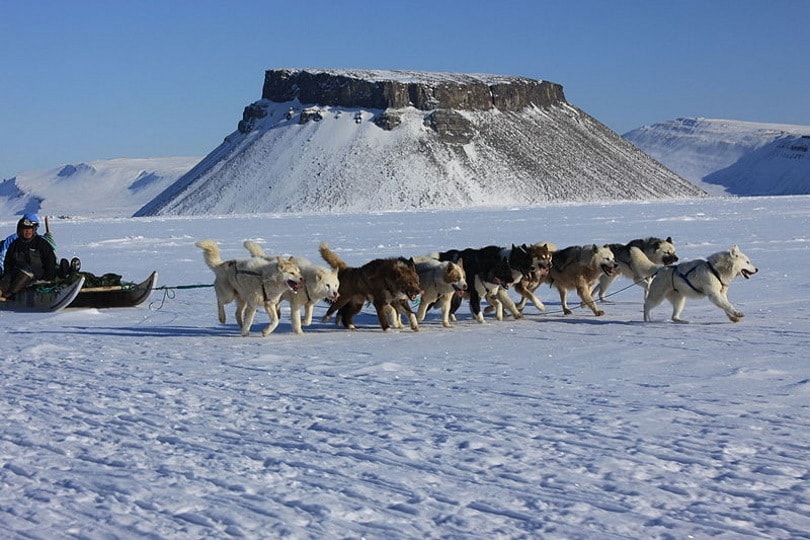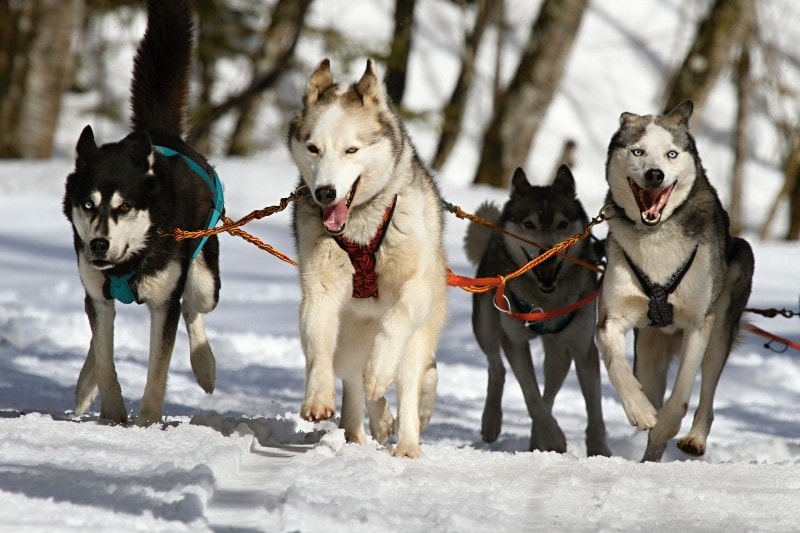
If you’ve ever been captivated by the fascinating world of sled dog racing, then you’ve probably wondered what it takes to train these incredible animals. Well look no further, as we unveil the secrets to mastering the art of sled dog training. In this article, we’ll equip you with some essential tips that’ll help you forge a strong bond with your team of four-legged athletes and unlock their true potential. So, let’s take a look at how to train your dogs to become amazing sled dogs.
By understanding the unique characteristics of each sled dog breed, you can tailor your training methods to suit their individual needs and maximize their potential. This will help you build a stronger bond with your team and ensure their overall well-being and success on the trail.

The 8 Tips on How to Train a Sled Dog
1. Establish Leadership With Your Sled Dog
In order to have a successful sled dog team, it’s important to establish a strong sense of leadership (and trust) with your dogs. Dogs are pack animals by nature and look to their leader for guidance and direction. By establishing yourself as a confident and reliable leader, you can build a stronger bond with your team and ensure their cooperation and obedience.
2. Consistent Discipline
One of the most effective ways to establish leadership with your sled dogs is through consistent and fair discipline. Dogs thrive on clear boundaries and expectations, so it’s important to set and enforce rules consistently. This can be done through positive feedback, such as rewarding good behavior with praise and treats, and discouraging unwanted behaviors through verbal commands and physical cues.

3. Establish Effective Communication
Consistent and effective communication is also key to establishing trust and leadership with your sled dogs. Dogs are highly attuned to body language and vocal cues, so it’s important to use clear and consistent signals to convey your expectations. This can be achieved through training sessions that focus on teaching your dogs basic commands, such as “go,” “stop,” “left,” and “right.” By practicing these commands regularly and rewarding your dogs for their correct responses, you can establish a clear line of communication and ensure that your team understands and follows your instructions on the trail.
4. Build Trust
Building trust with your sled dogs is another important aspect of establishing leadership. Trust is built through positive experiences and consistent care. It’s important to spend quality time with your dogs, providing them with regular exercise, affection, and mental stimulation. This not only strengthens the bond between you and your team but also ensures their overall well-being and happiness.
Training a sled dog requires time, patience, and a lot of dedication. Sled dogs are highly intelligent and energetic animals, so it’s important to approach their training with a systematic and consistent approach.

5. Bond With the Dog
First and foremost, it’s crucial to establish a solid bond with your sled dog. This can be achieved through regular interaction, playtime, and positive feedback. Spend time with your dog outside of training, get to know their personality, and build trust. A strong bond will lay the foundation for effective training.
6. Start With Basic Obedience Commands
The next step is to introduce basic obedience commands. Start with simple commands like “heel” and “come.” Use positive reinforcement such as treats or praise to reward your dog when they successfully follow the command. Consistency is key here – repeat the commands daily and gradually increase the difficulty level.
7. Introduce Sled Dog to Pulling
Once your sled dog has mastered basic obedience, it’s time to introduce them to pulling. Start with a lightweight sled or a cart and attach a harness to your dog. Begin by walking alongside the sled or cart, gradually increasing the distance and speed. Use verbal cues like “hike” or “mush” to encourage your dog to pull. Reward them with treats or praise when they exhibit the desired behavior.
As your dog becomes more comfortable with pulling, you can start adding weight to the sled or cart. Gradually increase the load over time, making sure not to overload your dog. It’s important to monitor their physical condition and not push them beyond their capabilities.

8. Seek Professional Training
It can be difficult to train a sled dog especially if you’ve never done so. There’s no shame in reaching out to a professional for help with training obedience commands and the act of pulling the sled as well. In fact, many sled dogs are professionally trained. A quick Google search will yield plenty of results for professional sled dog training as well as plenty of resources and videos if you want to give it another go yourself.
Essential Equipment for Sled Dog Training
When it comes to sled dog training, having the right equipment is as essential as training. Not only does it ensure the safety and comfort of your dogs (no matter the breed), but it also enables you to effectively communicate and control your team.
1. The Sled
One of the most important pieces of equipment for sled dog training is the sled itself. There are several types of sleds available in the market, each with its own set of advantages and disadvantages. Traditional wooden sleds have been used for centuries and are known for their durability and strength. These sleds are typically made from hardwood like ash or hickory, and they can withstand the rigors of rough terrain. However, they tend to be heavier compared to modern lightweight designs.
But on the other hand, modern lightweight sleds are also gaining popularity among sled dog enthusiasts. These sleds are made from materials like aluminum or carbon fiber, which significantly reduce their weight without compromising on strength. The lighter weight of these sleds makes them easier to maneuver and control, especially when navigating challenging terrains such as mountains or forests. Additionally, these sleds often come with adjustable features that allow you to customize the sled to your specific needs and preferences.
2. Harness
When it comes to sled dog racing or recreational mushing, having the right equipment is essential. Along with a sturdy sled, you will also need a set of harnesses for your dogs. These sled dog harnesses are specifically designed to distribute the pulling force evenly across the dog’s body, ensuring their comfort and safety during the activity.
The design of sled dog harnesses takes into consideration the unique anatomy and physiology of these working dogs. The harnesses are constructed in a way that allows for maximum efficiency in pulling, while minimizing any discomfort or strain on the dogs’ bodies. The pulling force is evenly distributed across the chest, shoulders, and back, preventing any undue pressure on specific areas.
Choosing the right sled dog harnesses is crucial to ensure the well-being of your dogs. Ill-fitting harnesses can cause discomfort and restrict their movement, which can lead to injuries or hinder their performance. It’s important to measure your dogs accurately and choose harnesses that provide a snug fit without being too tight. Adjustable straps and buckles allow for customization, ensuring a secure and comfortable fit for each individual dog.

3. Gangline
In the world of dog sledding, the gangline plays a crucial role in connecting the sled to the dogs. This essential piece of equipment serves as the lifeline between the musher and his team of dogs. The gangline must be constructed using strong and durable materials that can withstand the immense pulling force exerted by the dogs as they race through the snow. It’s not uncommon for a team of dogs to generate tremendous power, and a weak or faulty gangline could definitely result in accidents or injuries.
Regular inspection and maintenance of the gangline are of utmost importance to ensure its integrity. The musher should regularly check for any signs of wear and tear, such as fraying or weakened areas. Any damaged sections should be promptly repaired or replaced to avoid potential failures while on the trail.
4. Accessories
Other equipment that may be necessary for sled dog training includes booties to protect the dog’s paws from ice and snow, a snub line for securing the sled, and a sled bag for carrying essential supplies. It’s important to invest in high-quality equipment that is suitable for the specific needs of sled dog training, as this will contribute to the overall success and safety of your team.

Wrapping Things Up
Training a sled dog requires a systematic and consistent approach. Building a strong bond, instilling discipline, and training them consistently is what works to create an effective dog sledding team. With time and dedication, you can successfully train your sled dog to be a reliable and well-behaved team member.
Featured Image Credit: chepté-cormani, Pexels




